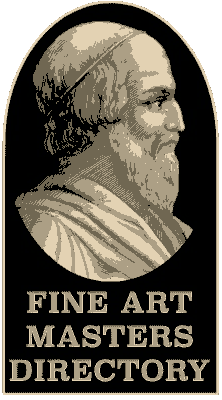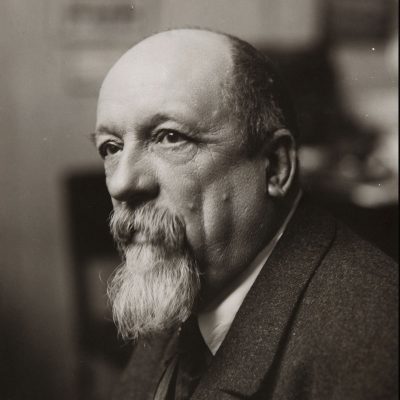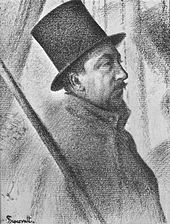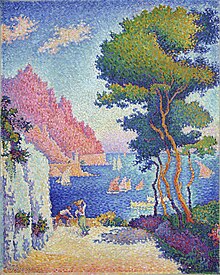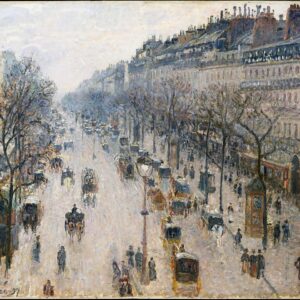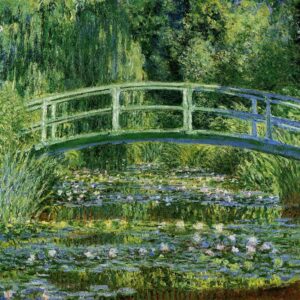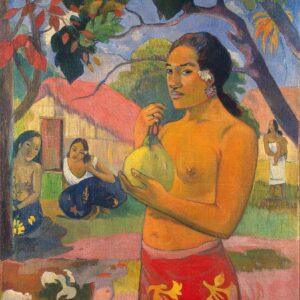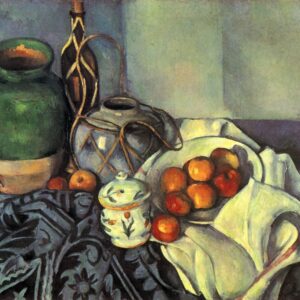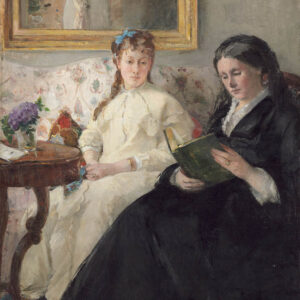Paul Victor Jules Signac (UK: /ˈsiːnjæk/ SEEN-yak,[1] US: /siːnˈjɑːk/ seen-YAHK,[2] French: [pɔl siɲak]; 11 November 1863 – 15 August 1935) was a French Neo-Impressionist painter who, working with Georges Seurat, helped develop the Pointillist style.
Paul Signac was born in Paris on 11 November 1863. He followed a course of training in architecture before, at the age of 18, deciding to pursue a career as a painter, after attending an exhibit of Monet‘s work. He sailed on the Mediterranean Sea, visiting the coasts of Europe and painting the landscapes he encountered. In later years, he also painted a series of watercolors of French harbor cities.
Portrait of Félix Fénéon, by Paul Signac in 1890, oil on canvas, 73.5 × 92.5 cm (28.9 × 36.4 in), Museum of Modern Art, New York
Portrait of Paul Signac by Georges Seurat in 1890, conté crayon, private collection
Portrait of his wife, Berthe, painted at Saint-Tropez by Paul Signac, 1893, Femme à l’ombrelle (Woman with Umbrella), oil on canvas, 81 x 65 cm, Musée d’Orsay, Paris
In 1884 he met Claude Monet and Georges Seurat. He was struck by the systematic working methods of Seurat and by his theory of colors and he became Seurat’s faithful supporter, friend, and heir with his description of Neo-Impressionism and Divisionism method.[3] Under Seurat’s influence he abandoned the short brushstrokes of Impressionism to experiment with scientifically-juxtaposed small dots of pure color, intended to combine and blend not on the canvas, but in the viewer’s eye, the defining feature of Pointillism.
The Mediterranean coast is a major theme across Signac’s paintings.[4] He left the capital each summer, to stay in the south of France in the village of Collioure or at St. Tropez, where he bought a house and invited his friends.
Paul Signac, Albert Dubois-Pillet, Odilon Redon, and Georges Seurat were among the founders of the Société des Artistes Indépendants. The association began in Paris 29 July 1884 with the organization of massive exhibitions, embracing as their motto, “Neither jury nor awards” (Sans jury ni récompense). “The purpose of Société des Artistes Indépendants—based on the principle of abolishing admission jury—is to allow the artists to present their works to public judgement with complete freedom”.[5] For the following three decades their annual exhibitions flourished and set the trends in art of the early twentieth century.
Capo di Noli, 1898, oil on canvas, 93.5 × 75 cm (36.8 × 29.5 in), Wallraf-Richartz Museum, Cologne
In 1886 Signac met Vincent van Gogh in Paris. During 1887 the two artists regularly went to Asnières-sur-Seine together, where they painted such subjects as river landscapes and cafés. Initially, van Gogh chiefly admired Signac’s loose painting technique. Signac would also meet Toulouse Lautrec who was a friend of Van Gogh.[6]
In March 1889, Signac visited van Gogh at Arles. In 1890 during the banquet of the XX exhibition in Brussels, Lautrec challenged to a duel the artist Henri de Groux who criticized van Gogh’s works. Signac declared he would continue to fight for Van Gogh’s honor if Lautrec was killed. De Groux apologized for the slight and left the group and the duel never took place.[7]
The next year he made a short trip to Italy, seeing Genoa, Florence, and Naples.
In 1888, Signac discovered anarchist ideas by reading Élisée Reclus, Kropotkin, and Jean Grave, who all developed the ideas of anarchist communism. With his friends Angrand Cross, Maximilien Luce, and Camille Pissarro he contributed to Jean Grave’s paper, Les Temps Nouveaux (New Times).
The Port of Saint-Tropez, 1901, oil on canvas, 131 x 161.5 cm (51.6 x 63.6 in), National Museum of Western Art, Tokyo
Signac loved sailing and began to travel in 1892, sailing a small boat to almost all the ports of France, to the Netherlands, and on the Mediterranean Sea as far as Constantinople, basing his boat at St. Tropez, which he later would make popular to other artists. From his various ports of call, Signac brought back vibrant, colorful watercolors, sketched rapidly from nature. From these sketches, he painted large studio canvases that are carefully composed of small, mosaic-like squares of color quite different from the tiny, variegated dots introduced and used by Seurat.
Signac experimented with various media. As well as oil paintings and watercolors he made etchings, lithographs, and many pen-and-ink sketches composed of small, laborious dots.
The Neo-Impressionists influenced the next generation: Signac inspired Henri Matisse and André Derain in particular, thus playing a decisive role in the evolution of Fauvism. Signac himself did not admire the style when it first appeared.[8]
Having prospered well, his financial support of the arts was considerable. As donations, he sent regular cheques and made a gift of his works for five lotteries between 1895 and 1912.[9] Signac’s 1893 painting, In the Time of Harmony originally was entitled, In the Time of Anarchy, but political repression targeting the anarchists in France at this time forced him to change the title before the work could be accepted by a gallery.[10]
The Lagoon of Saint Mark, Venice, 1905 oil on canvas, 129.5 x 162.6 cm, Chrysler Museum of Art
At the 1905 Salon des Indépendants, Henri Matisse exhibited the proto-Fauve painting Luxe, Calme et Volupté. The brightly colored composition was painted in 1904 after a summer spent working in St. Tropez on the French Riviera alongside the neo-Impressionist painters Henri-Edmond Cross and Paul Signac.[11] The painting is Matisse’s most important work in which he used the Divisionist technique advocated by Signac, which Matisse had adopted in 1898 after reading Signac’s essay, d’Eugène Delacroix au Néo-Impressionnisme.[12][13] Signac purchased the work after the 1905 Salon des Indépendants. In 1908 Signac was elected president of the Twenty-fourth Salon des Indépendants.[14]
As president of the Société des Artistes Indépendants, from 1908 until his death, Signac encouraged younger artists by exhibiting the controversial works of the Fauves and the Cubists. He was the first patron to buy a painting by Matisse.
Signac served as a juror with Florence Meyer Blumenthal in awarding the Prix Blumenthal, a grant given between 1919 and 1954 to painters, sculptors, decorators, engravers, writers, and musicians.[15]
